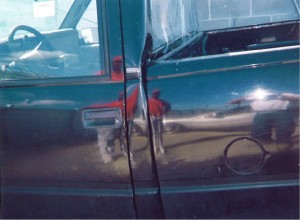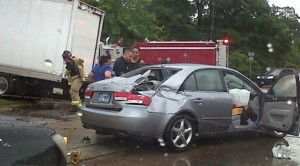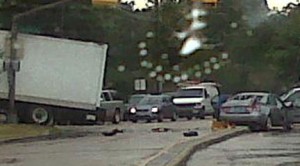Smith & Hassler has previously posted to this blog about the importance of photographing your injuries for a personal injury claim. This post discusses photographing damage to your vehicle and how property damage photographs may be useful evidence in presenting an injury claim to an insurance company.
Generally speaking insurance companies think in a linear way when it comes to the interaction of property damage and injury claims. The worse the damage to your vehicle, the more likely an insurance company is to believe you that you were injured and need medical treatment (assuming you do not have an obvious or objective injury, such as a laceration or broken bone). On the flip side, if there is very little damage to your vehicle, an insurance company will question whether you were injured at all. In fact it has routinely been our experience at Smith & Hassler that shortly after an injury claim is set up, insurance companies mail us photographs of our client’s vehicle showing minor damage with a letter enclosed stating that due to the minor damage, the insurance company expects that there would be very minor injuries and very little medical treatment. State Farm Insurance particularly likes to mail minor property damage photographs.
The reality is that while there is a relationship between property damage and the likelihood of injury, the relationship is not simple or straightforward. Different types of vehicles react differently to collisions. For example: you would expect to see different types and amounts of damage to the back of a Honda Civic than you would a Chevrolet Suburban: the vehicles are made of different materials, have different ground clearances and bumper heights and weigh different amounts.
Another example is when one full-size pickup truck rear-ends another full-size pickup truck. Texas is “truck country” after all, so at Smith & Hassler we see a lot rear-end automobile accidents involving pickup trucks. Because of the way pickup trucks are constructed many makes and models can weather a hard rear-end collision yet show very little damage for it, often not much more than a somewhat bent-down rear bumper.
There is also the fact that people react differently to impact forces. A person who has had decades of neck pain and a prior neck surgery may suffer significant pain and injury from an apparently quite mild rear-end collision, whereas the person sitting next to them who has never had neck pain may experience no injury at all.
Still: insurance companies know that photographs showing minor damage to the injured person’s vehicle can create problems if the injury claim winds up in front of a jury. Insurance defense attorneys use the photographs to characterize the accident as extremely minor…barely a tap…not the type of accident that could cause a person injury.
Some insurance companies, most notably Allstate Insurance, make a special effort to take plenty of photographs of an injured person’s vehicle that has little damage. They will keep the photographs in their file and seek to introduce them as evidence if a lawsuit is filed on the claim. However: they go out of their way NOT to take photographs of an injured person’s vehicle that has been badly wrecked. They don’t want to take photographs of a badly wrecked car because they would be required to produce those photographs to the injured person’s attorney if a lawsuit is filed, and they know the photographs will help the injured person at trial. There is no guarantee that a judge will allow photographs of the vehicles into evidence at trial, but many many insurance companies try to skew the evidence in their favor from the beginning.
Before you take photographs of the damage to your vehicle you should keep in mind that if your injury claim goes into litigation (in other words, you hire an attorney and a lawsuit is filed over your injuries), the photographs will have to be produced to the insurance defense attorney if they request them (and they always do request them). If there was severe damage to your vehicle you should take lots of good quality photographs from multiple angles showing the extent of the damage. Here are a few bullet point suggestions:
- Take plenty of photographs. Digital photographs are free to take and easy to store on a computer, so it costs you the same to take 50 pictures as it does to take 5 pictures.
- If the airbags in your vehicle deployed, take some interior photographs showing the airbags were deployed.
- Look for “transferred damage” and photograph it. Transferred damage is damage to your vehicle that was not the result of a direct impact to the damaged area, for example: in a severe rear-end collision the rear roof pillars or the roof itself may become buckled from the force of the impact.
- In a rear-end impact, particularly to a a large SUV or full-size pickup truck, look underneath the rear of the vehicle because bumper mounting brackets may be buckled or broken. Take photographs.
- In a rear-end collision involving a pickup truck, check to see if the bed of the pickup truck was pushed forward and damaged the rear of the cab. An example of this type of damage is inserted below.
- Don’t just leave the photographs on your camera and assume they will be safe. What if you lose your camera or there is a problem with the memory card? Transfer your photographs to your PC or laptop and think about uploading them to a web site that hosts pictures for free, such as www.kodakgallery.com or www.photobucket.com – make sure that the photographs are private and not available to just anyone.
- Don’t put the photographs on your Facebook or MySpace page! If you post the property damage photographs to a social networking web site and your injury claim goes into litigation, you open the possibility of the insurance defense attorney being able to get discovery of your Facebook page because you posted information related to the car accident.

This photograph is an example of damage from a rear-end collision to a pickup truck where the truck bed was pushed forward into the cab.
If you, a friend or a family member have been injured in a car accident, Smith & Hassler’s experienced personal injury attorneys are available to give you a free consultation either in-person or by phone. Sometimes people injured in car accident wait before consulting an attorney. They have good intentions: not wanting to seem “sue happy,” waiting to see if their injuries will get better or because an insurance adjuster is discouraging them from seeking legal advice (that happens). It is better to know your rights early in the process and have an experienced Houston personal injury attorney explain the steps involved in car accident injury claim and what you can do NOW to increase the chances of a good outcome.








